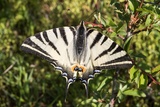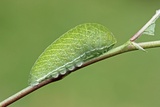Iphiclides podalirius (Linnaeus, 1758) Species
Last modified: Sept. 7, 2023, 5:59 p.m.
A local and endangered species in Belgium, populations are mainly present on calcareous grasslands in the south of Belgium. Elsewhere this species is a very rare vagrant.
Details
- Classification
- Family: Papilionidae > Subfamily: Papilioninae > Tribus: Graphiini > Genus: Iphiclides > Species: Iphiclides podalirius
- Vernacular names
- Koningspage (NL), Scarce Swallowtail (EN), Flambé (FR), Segelfalter (DE)
- First mention in Belgium
- De Sélys-Longchamps E. 1837. Catalogue des Lépidoptères ou Papillons de la Belgique, précédé du tableau des Libellulines de ce pays. — — : 1–29. On page 14 (as Papilio podalirius). view page
- Status
-
Native
Distribution
Imago
An unmistakable large species with a whitish to pale yellow ground color and black "tiger" stripes crossing the wings. On the outer edge of the hindwing there are some blue lunules, the inner one topped with orange, and the hindwings have a pair of long conspicuous tails. Wing lenght: 32-39 mm.
Egg
Eggs are laid singly, mainly on the upperside of the leaves of the larval foodplant. The eggs are relatively large, pale and spherical.
Bionomics
Bionomics are described elaborately on the Butterflies in the Benelux website.
Flight periods
In Belgium the adults fly in two generations a year: the main generation in May and June, and a partial second generation from late July to early September.
Observed on
- Host plant (species):
- Prunus spinosa
- Host plant (genera):
- Prunus
The larva lives on small shrubs & trees of the Rosaceae family. In Belgium mainly on Prunus spinosa, but also Crataegus monogyna can be used.
Habitat
In Belgium this species is mainly confined to calcareous grasslands that combine the thermophilic character of the species with a large amount of young scrub with the larval foodplant.


